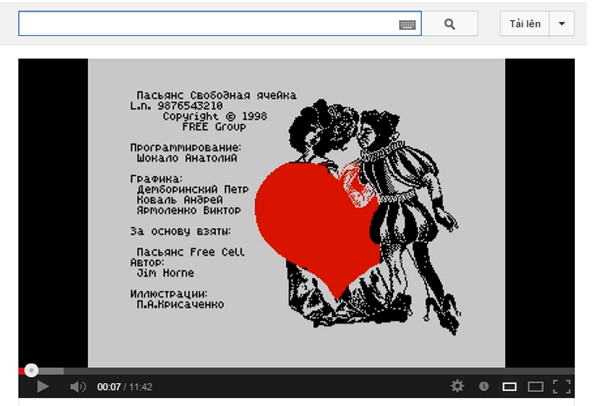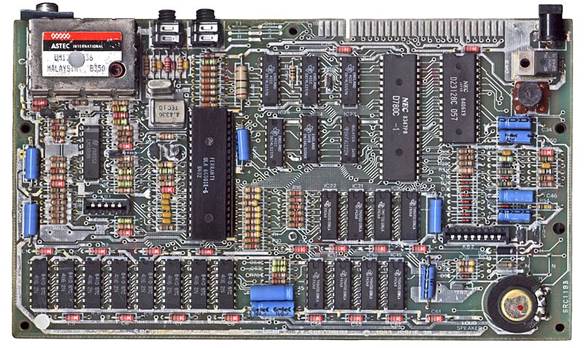We take a peek behind the Iron
Curtain, and weirdly finds many clones of the ZX Spectrum hiding there.
In the UK in the 80s there was no better
computer than the Sinclair ZX Spectrum (unless you felt the Commodore 64 was
your thing). It emerged in Britain in 1982 and until the late 1980s was a
dominant force in the computer industry. Mainly used for games, but also
featuring some serious or educational activities, the ZX Spectrum was a great
little machine.
While we in the UK thought the Spectrum was
pretty super, there were other countries in the world who thought the Sinclair
machine was even better than that. One such country was the former Soviet
Republic, who liked the machine so much they copied it over and over again. If
imitation is really the sincerest form of flattery, then the Russians flattered
Sir Clive Sinclair’s computer to death.

ZX
Spectrum
This feature will look at the background to
this Soviet Spectrum love, as well as the machines themselves and the software
the Russians wrote for them. It will also look at the remarkable longevity of
the Spectrum in the Eastern Block, with devices still being made, sold and used
well into the 2000s.
The Soviet Computing Era
The Russians, of course, had their own
computers, with exotic (well, Russian) names such as Lvov, Elektronika and
Plyclin. However, they were all just a little bit behind the times, being a
little bit 19705 in their workings, when the rest of the world was in the
1980s.

If
you can speak Russian, then you can play Solitaire on your Pentagon 128
It’s not true that nothing good came from
these Russian computers, though, as we all know that Tetris was written on an
Elektronika, so that makes it a great computer. Nevertheless, for many Russians
there were two problems with the Russian-built machines. Firstly, they were too
expensive for many, and secondly, the software on them was very limited,
particularly where the games front was concerned.
Then news got through to Russia of Sir
Clive Sinclair’s little plastic and rubber wonder and things began to change.
Some Russians had always liked certain
elements of Western culture, particularly the more decadent aspects. You only
have to read the many writings about the popularity of bootleg Beatles records
in the 605 and 70s to realize that among certain parts of Russian society there
was a feeling that not everything in the West was bad. This also happened with
the ZX Spectrum.

Many
Scorpions are modified to within an inch of their lives
Sir Clive was a wily old fox, but he wasn’t
wily enough to actually export his own Spectrums to Russia although he may have
lasted longer as a computer manufacturer if he had worked out how to do this.
What actually happened is that a few models were smuggled across the Iron
Curtain and then copied... and boy oh boy, how they were copied.
Cloned in their hundreds of thousands the
Spectrum spread like wildfire across the country. With not just one make but
tens of different makes and models.
Now, then, is a good time to take a look at
some of the more interesting models that were available.
The Soviet Spectrums
In terms of legality, the Russian Spectrums
are a grey area. They are pretty much reverse engineered devices in the main,
meaning they used slightly different components but got the same result.
Therefore, they didn't use any copyrighted parts, but it’s still probable that
Sir Clive did not like these clone machines.

Timex
Sinclair 2068
The most widely known Spectrum clone in
Russia is probably the Pentagon 128. I'm not really sure whether the name is
ironic about the US or not, but the machine itself is quite interesting. Rather
than being a complete computer, it would arrive in kit form for the user to
build themselves (strangely like earlier official Sinclair kit). It also
featured a range of add-on parts such as generic keyboards and joysticks and
disk drive interfaces, allowing the user to create quite an impressive setup.
The Pentagon 128 used no official Sinclair pans but was pretty compatible with Spectrum
software from the West, making its popularity even higher among the Russian
population.
Like most Russian clones, it often looked
like it was fitted with an aftermarket keyboard in the style of UK favorite
hardware manufacturers like Sage or D K Tronics (which, for those who don‘t
remember, made proper keyboards that slotted around your rubber keyed device).
However, not all Soviet clones were quite as conventionally designed.
A particular favorite of mine is the
Nafanja, which not only had a built-in joystick port, but also had round rubber
keys, which surely would have made typing anything lengthy nearly impossible.
Others, such as the Digra, look like ancient adding machines rather than
computers.
What’s most impressive, though, is the
sheer ingenuity of the clone manufacturers. They used whatever parts they could
lay their hands on to create their machines. It was clearly not easy to get
many components in Soviet Russia, but these enthusiasts managed it somehow and
were then able to get enough to manufacture the computers in quite high
numbers.
They also took what Sir Clive had made and
ran with it. They added extra memory (often 16KB more), joystick ports and
strange keyboards. They also added disk drive interfaces and gave their humble
Spectrum clones the ability to run the CP/M operating system... this had the
effect of widening the software available to the enthusiasts even more. It took
Amstrad to allow CP/M onto the ZX Spectrum in the West, with the building of
the Spectrum +3 in the late 80s, adding a strange 3” disk drive to its newly
acquired computer. In this respect, the Russian amateurs had beaten the
professionals to it.
There was another clone Spectrum in Russia
that rivaled the Pentagon for popularity, and that was the Scorpion. The Scorpion
is interesting in just how many peripherals there were available for it. There
are many examples online (just Google ‘Russian Spectrum Scorpion’) of the
Scorpion in IBM PC-AT cases, with hard drives and professional monitors. Even
more interesting are Scorpions built into almost modern looking PC tower cases.
The Scorpion sold well, although possibly not as well as the Pentagon and, as
with the others, allowed hobbyists and amateurs to get access to computer
technology that was not officially available to them.

Hardware
of ZX Spectrum
There was even a slightly official clone
that was used in many schools, which was called, interestingly, the Hobbit
8030. It was a really well put together machine too. In many respects it was
what the Amstrad versions of the Spectrum should have been. Released in the
late 19805 but still being updated and sold well into the 1990s, the Hobbit
wasn’t as cheap as some clones but offered a professional keyboard, more
memory, a disk interface and even more interestingly a network interface. Not
only that, but as well as Sinclair BASIC, the Hobbit also had the Forth
programming language available to it (shades of the Jupiter Ace here perhaps).
In the early 1990s, the Hobbit computer was even sold in small numbers by some
sellers in the UK, although its use of the Russian alphabet meant it was mainly
bought by ex-pat Russians.
On top of the more popular ones, there were
hundreds of other clone makes available to Russians who wanted a Spectrum
compatible computer. There was the Baltic, the Kvorum, the Leningrad, the
Magik, the Master, the Robik, the.... Oh, alright, far too many to mention.
In many ways, the late 1980s Soviet
computer scene looks remarkably similar to the 1970s California computer scene
you read about with people like Steve Jobs or Nolan Bushnell. It was a time
when computer clubs ruled, and people would share ideas, intelligence and parts
at small meetings to create working computers.
Let’s now look, though, at what sort of
software the Russians ran on their Spectrum clones.